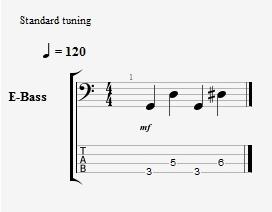Jazz Bass Lines, Concepts And Play Alongs
 Jazz; easy to learn but hard to master. Jazz is one of those few styles that expands and goes past the average intermediate phase.
Jazz; easy to learn but hard to master. Jazz is one of those few styles that expands and goes past the average intermediate phase.
Jazz guitar makes full use of many theoretical concepts, and also tends to use a lot of the more difficult concepts in music, such as improvisation and proper usage and implementation of the chromatic scale.
In this lesson, we will show you a couple of jazz bass lines that will help to open your eyes to the use of chords and chromatics within jazz bass guitar playing.
Get a Hold of the Fundamentals Before Tackling This
First off, before we begin, it is important that you take a look at your skillset. Jazz bass guitar requires a ton of practice, and it also requires a ton of skill. While both of your examples aren’t hard (one consists of quarter notes only), the second requires quite a bit of dexterity.
If you aren’t comfortable with the chromatic scale and the use of all four fingers when fretting, you may want to take some time to practice before approaching these two examples. Take a bit of time to yourself to develop proper finger independence. Not only will this allow you to play the second example (a chromatic bass line) more efficiently, but it will reduce any possible strain to your wrist due to poor form.
How Keen Are Your Senses to a Groove?
Another important thing to consider before diving headfirst into these examples is whether or not you have developed a full rhythmic sense. If you have trouble playing within your time signature and constantly find that your note values are slightly off, you may want to take some time to practice with a metronome.
Our two examples are extremely different; the first is extremely basic, the second is a bit more advanced. This means that you will need a fully developed sense of rhythm in order to approach it. If not, you may find yourself having trouble playing along to the example.
Now that we have stressed the importance, it’s time for the bass guitar lines.
Example 1 – Taking It Simple

Download the .gtp file for the lesson ( Right click and Save As… )
If you do not have GuitarPro yet, download a copy of Guitar Pro instantly here…
This example is a basic line which outlines the following pattern; root, fifth, root, half step up. This pattern outlines the basic G Major triad without using the third. This means that it can be played with any triad consisting of the notes G and D or G and D#.
The pattern is extremely basic, but also fairly versatile as it uses the triad and the chromatic note to give it more possible applications.
Example 2 – A Chromatic Approach to Jazz Lines

Download the .gtp file for the lesson ( Right click and Save As… )
This example is fully chromatic. The best way to learn this pattern is by playing along to a metronome. Allow yourself to get a full feel for the notes and their placements before tackling it at full speed.
This pattern was designed to show you just a single possibility of using the chromatic scale. It covers a fair amount of distance, while still staying within a short range.
Once you have learned these two jazz bass lines, the next step is to create your own. Keep your mind open, and try different angles when approaching your bass lines. You never know what might come out.
For more ideas on bass lines creations, check out this video…
Check Out The Perfect Learning Tool For Bassists of All Skill Levels
JamPlay offers the best online bass instructions on the Internet. With hundreds of professionally recorded lessons, Jamplay is the ideal place to learn the basics and improve your bass playing skills. With great teachers and carefully planned lesson structures, I guarantee you will be able to take your bass playing to a higher level in no time.
Related Articles
Comments are closed.





